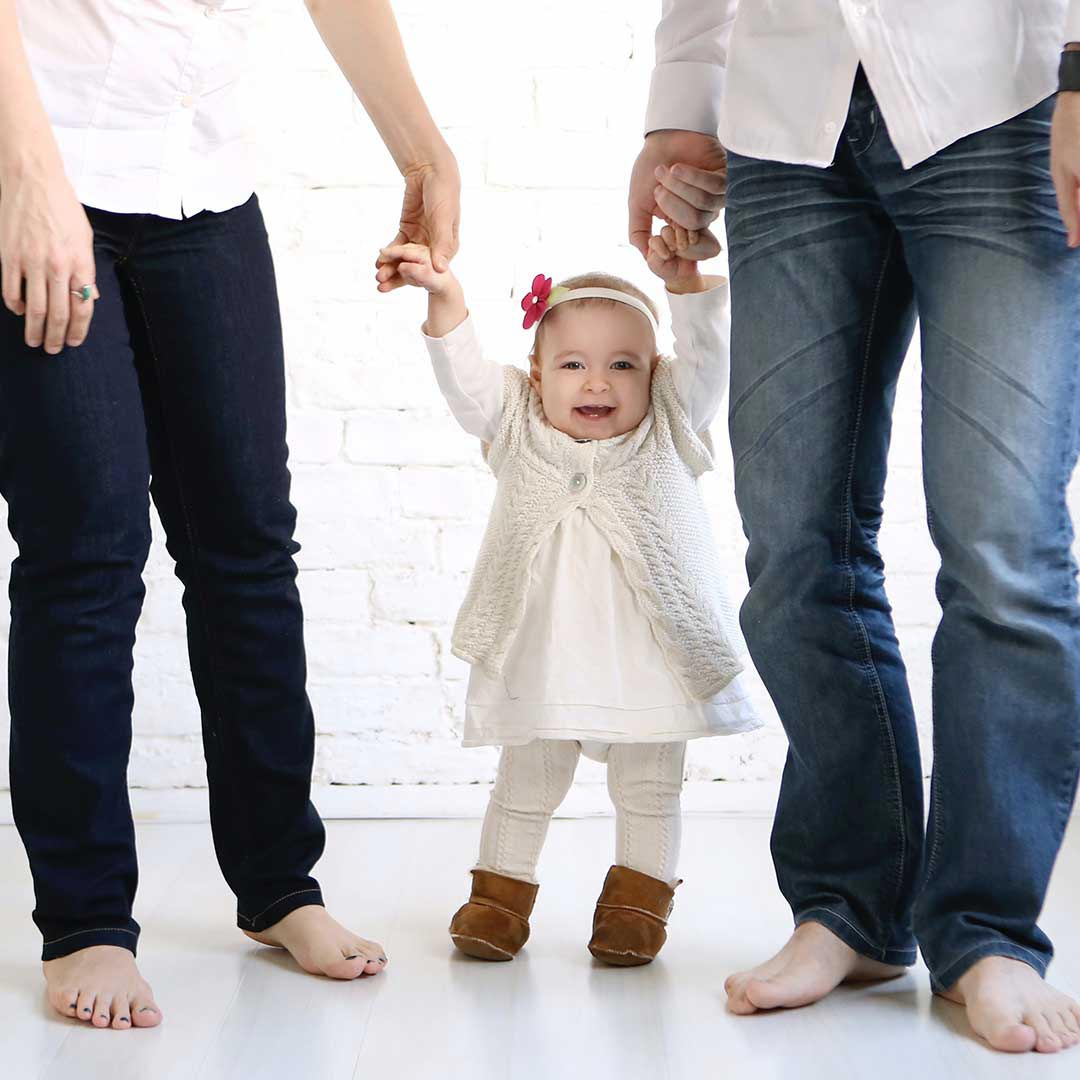Just when you thought you’d tackled the 12 month sleep regression and could count on some quiet nights of good sleep, your 15 month old is up in the night and upset! Time for the 15 month sleep regression!
Signs of the 15-Month Sleep Regression
If your toddler is experiencing a sleep regression, you may notice the following:
- Increased fussiness during bedtime or nap transitions.
- Multiple night wakings, even if they’ve been sleeping through the night.
- Fewer naps or short “disaster naps” that leave them cranky.
- Changes in appetite, including being hungrier or pickier.
- Resisting bedtime, often wanting to stay active instead.
All sleep regressions occur because your child’s body and brain are preparing for — or right in the middle of — a major developmental change. As adults it’s hard to really understand how challenging this time can be for babies. We certainly don’t remember what it was like when we went through it. But as your child is learning a new skill (like walking ) or realizing something new and amazing about their world (for example, that objects fall to the ground when you drop them), their bodies and brains are working HARD. So hard, in fact, that they just may not be able to keep up the skills and strategies they have learned to calm themselves, to sleep quietly through their sleep cycles, and even to play happily on their own.
Have no idea where to begin solving your child’s sleep issues?
Start with this guide.
What’s Happening to My Baby?
Two major changes happen that can cause the 15 month sleep regression. Many toddlers are learning to walk independently, and most begin transitioning from two naps to one nap a day. No matter where your child is on the spectrum of walking — still holding on to your hands or running across the room into your arms — they are likely on the move A LOT! Just like when they learned to sit up or to crawl, you may find your toddler practicing her new skills in bed instead of sleeping. She may be more excited to walk around her room at bedtime than to sit and read a book, or lie on the changing table for her diaper and jammies, than she is to go to bed.
What’s Causing the 15-Month Sleep Regression?
Sleep regressions often align with exciting developmental milestones and other changes in your toddler’s world. At 15 months, several factors might disrupt sleep:
- Developmental Milestones: Many toddlers are learning to walk independently or even run. This new mobility can be exciting and overstimulating, leading them to practice skills in the crib instead of sleeping.
- Nap Transitions: Around this age, toddlers begin transitioning from two naps to one. While the transition is natural, it can lead to overtiredness and night wakings if handled too quickly.
Kim Says: “Most toddlers aren’t ready to fully drop to one nap until 16–18 months. Keep offering two nap opportunities as much as possible during this adjustment phase to prevent overtiredness.”
- Separation Anxiety: This stage often brings heightened awareness of being apart from parents. Bedtime can trigger feelings of anxiety as toddlers process that you’re leaving the room.
Kim Says: “Separation anxiety is a natural part of development. Brief, consistent bedtime routines and a comforting goodbye ritual can help your toddler feel secure as they drift off to sleep.”
- Teething or Illness: Emerging molars or minor illnesses like colds can cause discomfort, making it harder for your toddler to settle.
- Overtiredness: If your toddler skips naps or has shorter daytime sleep, it can lead to bedtime struggles and more frequent wake-ups at night.
Wondering about schedules for your toddler?
Read: Sample Schedules: Sleep and Naps From 6 Months to Preschool
At her 12 month sleep regression your toddler may have faked you out, appearing to be ready for only one nap per day when she really still needed two. Now, at the 15 month sleep regression, that transition is real and appropriate, but not easy! Some days she refuses her nap altogether and is ready to keep playing when you get her up and out of her room. Other days she may fall apart by midday and fall asleep in the car on afternoon errands. Other toddlers will come unraveled in the evening as their bodies transition and adjust to less sleep. Overall, bedtime (and nights) may get rough. Less daytime sleep can leave your baby overtired at bedtime and harder to get to bed smoothly. Being overtired can also contribute to more night wakings.
Need some more information about those naps?
Read: Baby and Toddler Naps — Everything You Need to Know

How to Support Your Toddler During the 15-Month Sleep Regression
The good news is that sleep regressions are temporary. Here’s how you can support your toddler during this phase:
1. Stick to a Predictable Routine
A consistent nap and bedtime routine helps toddlers feel secure and signals that it’s time to sleep. Incorporate calming activities like a warm bath, storytime, or cuddling with a lovey.
Kim Says: “Consistency is key during sleep regressions. Predictable routines give your toddler the reassurance they need to settle down, even during challenging phases.”
2. Be Flexible with Nap Transitions
Some toddlers may start resisting their second nap, but most still need two naps until closer to 16–18 months. On days when naps don’t go as planned, consider moving bedtime earlier to prevent overtiredness.
Kim Says: “Even if your toddler resists one of their naps, keep the second nap slot as a quiet rest period. This consistency helps ease the transition to a one-nap schedule when they’re ready.”
3. Offer Comfort Without Creating Sleep Props
It’s natural to want to soothe your toddler during wake-ups, but try to avoid reintroducing habits like rocking or nursing to sleep. Use gentle sleep coaching techniques, like the Sleep Lady Shuffle, to offer comfort while encouraging independent sleep skills.
Kim Says: “Supporting your toddler doesn’t mean doing all the work for them. Gentle sleep coaching allows you to stay present while empowering your child to self-soothe.”
4. Address Separation Anxiety
If your toddler is struggling with separation anxiety, consider introducing a comfort object, like a small blanket or stuffed animal. Reassure them with your presence at bedtime, but keep interactions brief during night wakings.
5. Adjust for Developmental Milestones
Toddlers often practice new skills like walking or climbing during naps or bedtime. To help them settle, provide plenty of opportunities to practice these skills during awake times.
Kim Says: “Toddlers are naturally curious and driven to master new skills. By giving them space to practice during the day, they’ll be less tempted to do so in the crib at bedtime.”
6. Manage Teething and Discomfort
If teething is a factor, offer safe remedies like a chilled teething ring or consult your pediatrician about pain relief options.
Talk to a Gentle Sleep Coach and get sleep help!
Book a 20-minute call for just $45.
How Long Does the 15-Month Sleep Regression Last?
Most sleep regressions last 2–4 weeks, though this varies from child to child. Staying consistent with routines and gentle sleep coaching will help guide your toddler back to more stable sleep patterns.
When to Seek Additional Support
If sleep disruptions persist beyond six weeks or are significantly impacting your toddler’s well-being, it may be time to consult a pediatric sleep expert. A Gentle Sleep Coach can help you develop a personalized plan tailored to your toddler’s temperament and family’s needs.
Kim Says: “Sleep regressions can feel endless, but with the right strategies—and support if you need it—you’ll come out on the other side stronger and more confident in your child’s sleep skills.”

What Can I do to Get Through the 15 Month Sleep Regression?
Sleep Training During the 15-Month Sleep Regression
The 15-month sleep regression can feel like the perfect storm of disrupted nights, developmental leaps, and nap transitions. Many parents wonder: Is this the right time to implement sleep training? The short answer is yes—with some key considerations.
Sleep regressions are temporary, but they’re also an opportunity to build sleep habits that support your toddler’s healthy development. By using gentle sleep training methods tailored to your toddler’s temperament and unique needs, you can help them regain their confidence in self-soothing and independent sleep
Gentle Sleep Training During a Regression
Sleep training doesn’t mean leaving your toddler to cry it out. Kim West’s Gentle Sleep Lady Shuffle offers a compassionate approach to help your toddler learn awake time skills and fall asleep independently, all while providing extra comfort and reassurance.
Kim Says: “Sleep regressions are challenging, but they’re also the perfect opportunity to teach your child the skills they’ll need for long-term, restful sleep. Gentle methods allow you to stay present and supportive without creating new sleep crutches.”
Here’s how to approach sleep training during a regression:
- Stick to Your Bedtime Routine
A consistent bedtime routine signals to your toddler that it’s time to wind down, even when sleep feels harder to achieve. Keep bedtime calm and predictable with familiar activities like a warm bath, a favorite story, and quiet cuddles. - Start with a Customizable Sleep Training Plan
Every child is different. A customizable sleep training plan lets you adapt strategies to meet your toddler’s specific needs while addressing the challenges of sleep regression timing.Kim Says: “There’s no one-size-fits-all solution. The best sleep training plan is one that aligns with your child’s unique personality and developmental stage.”
- Focus on Regression Support
During sleep regressions, your toddler may need a bit more reassurance. Provide comfort when needed, but aim to reduce interventions gradually. For example, if your toddler wakes crying, offer a soothing pat or soft words instead of immediately rocking them back to sleep. - Encourage Independent Sleep Skills
Teaching your toddler to fall asleep on their own—even during regressions—builds their confidence and sets the stage for long-term sleep success. Use gentle methods to minimize frustration while encouraging progress.
Comparing Methods: What About Other Sleep Training Approaches?
Parents often hear about cry-it-out or rigid schedules, but these methods may feel too harsh during a regression. While some families find success with these techniques, Kim West advocates for approaches that combine gentle sleep training methods with flexibility and responsiveness.
- Cry-It-Out (CIO): While effective for some, CIO often leaves both parents and toddlers feeling distressed. This method is not recommended if you prefer a more responsive approach.
- Ferber or Timed Check-Ins: This method involves checking in on your child at increasing intervals. While it can work for some families, it may not provide the level of extra comfort and reassurance needed during regressions.
- Gentle Sleep Lady Shuffle: Kim’s method focuses on staying close to your child while gradually building their self-soothing skills. You can adapt the pace based on your toddler’s needs, ensuring they feel supported while learning to sleep independently.
Kim Says: “The Shuffle gives you the flexibility to comfort your child while teaching them the tools they need for healthy sleep. It’s a gentle, customizable approach that works with your child—not against them.”
Final Thoughts
Sleep training during the 15-month sleep regression is about striking the right balance between support and independence. By focusing on healthy sleep habits, consistent sleep training, and tailored strategies, you’ll help your toddler navigate this phase with confidence.
Remember, this regression is a temporary stage of growth, and your efforts now will pay off with smoother nights ahead. If you’re feeling stuck, reaching out to a pediatric sleep consultant can provide additional guidance and help you fine-tune your approach.
Kim Says: “Every sleep regression is an opportunity to teach your child resilience and self-soothing skills. Stay patient, trust the process, and know that restful nights are just around the corner.”
Self-Care for Parents
Navigating a sleep regression is exhausting for parents too. Remember to prioritize your well-being:
- Rest when you can, even if it means asking for help or letting non-urgent tasks wait.
- Share the load with your partner or support network to ensure you both get breaks.
- Remind yourself that this phase is temporary—your toddler will return to more restful sleep soon.
Kim Says: “Taking care of yourself isn’t selfish; it’s essential. Rested parents are better equipped to support their toddlers through tough transitions.”
Final Encouragement
The 15-month sleep regression is challenging but also a sign of incredible growth for your toddler. By staying patient, consistent, and responsive, you’ll help them navigate this phase and emerge with new skills and confidence. Trust in the routines you’ve built, lean on your support system, and know that better sleep is just around the corner.
Kim Says: “Every sleep regression is an opportunity to teach your child resilience and build healthy sleep habits for the future. Hang in there—you’re doing an amazing job.”




